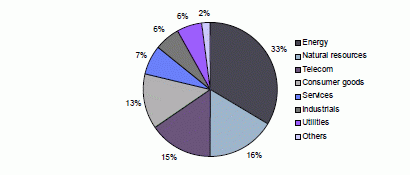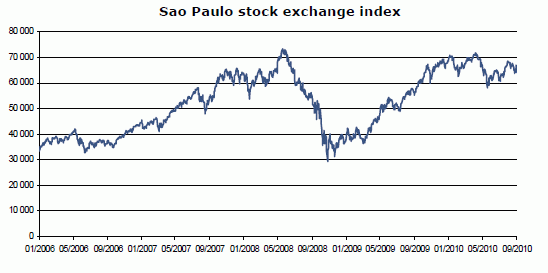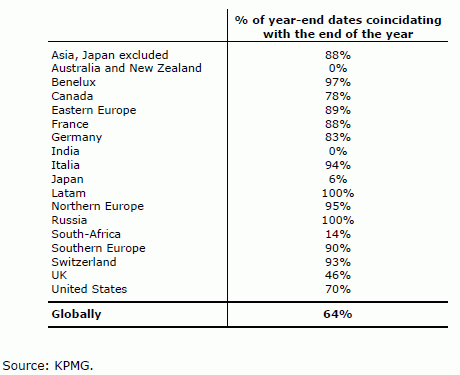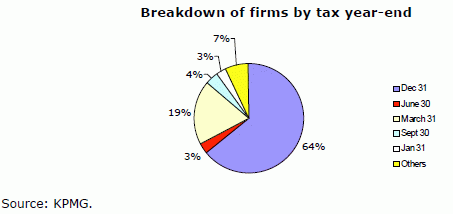Letter number 52 of September 2010
ALL ARTICLES
- TOPIC
- STATISTICS
- RESEARCH
- QUESTIONS & COMMENTS
News : Financial analysis of Brazilian groups
In December 2009, 377 Brazilian firms were listed on the Sao Paulo stock exchange. If we eliminate firms operating in the financial sector, firms that have filed accounts for less than four years and very small firms, we are left with 182 firms that account for 97% of the Brazilian market capital (with is around €930bn, or two-thirds of the market capital of Euronext Paris or about the same as that of Australia).
We analysed these companies using standard financial analysis methods (1). Any readers wanting to consult their audited accounts can request copies via the letter box on www.vernimmen.com. Most of them end their financial year on December 31st.
Wealth creation
The combined sales of the Brazilian companies in the sample is €382bn, or the equivalent of the combined sales of BP and Shell.
There is a very large gap between the biggest and the smallest listed Brazilian companies. 20% of the biggest account for 80% of sales and 86% of EBIT with average sales of €8bn and average EBIT of €1.4bn.
On the other hand, 20% of the smallest account for 0.6% of sales, -3% of EBIT with average sales of €66m and average EBIT of -€1.7m.
Concentration is much higher than in China (2) and similar to that of India (3).
Energy is the leading sector, with 33% of total sales, experiencing a slow relative decline over recent years, with telecoms and consumer goods taking on a larger share. Natural resources, often cited as an emblematic sector in Brazil, are in decline and only accounted for 16% of 2009 sales:
Unsurprisingly, these listed companies have experienced high growth since 2006, with average growth of 9% per year. With an annual inflation rate of around 5% in Brazil, these companies have grown in volume by around 4% per year, a higher rate than the Brazilian economy as a whole, which only grew in volume by around 3.4% per year over this period.
This strong growth has been accompanied by stable operating margins, with the exception of 2009:
For comparative purposes, in 2009, the operating margins of European groups were around 11%. Unlike China (where this ratio was 9%) which specialises in low-price exports, Brazil is able to capitalise on its natural resources and its high value-added products.
Capital expenditure
No weak spots were identified in the management of capital employed:
Working capital is constantly improving in number of days of sales:
Unsurprisingly, given its growth in volume which is closer to that of developed countries than of China or India, capital expenditure only amounts to 1.4 times depreciation and amortisation.
Financing
Given that the country is no longer experiencing spectacular growth and thanks to good earnings, as we shall see further on, the Brazilian companies in our sample have, since 2007, generated free cash flows after financial expense that are more or less balanced:
The increase in debt, which rose by two-thirds between 2006 and 2009 remains reasonable overall, representing 1.5 times 2009 EBITDA, which is the average for the European majors.
Profitability
The profitability of listed Brazilian firms is acceptable with after tax ROCE at around 10% in 2009 (16% in previous years) for a cost of capital of 12%. Return on equity is even better given the moderate leverage effect of around 15% in 2009 and 20% previously.
By paying out 49% of their profits in the form of dividends, Brazilian groups have adopted a dividends policy in line with growth that is slowing down, even though the Brazilian growth rate would be considered enviable in developed countries, especially at the moment.
In fact, the only financial features of listed Brazilian firms that link them to emerging countries are their stock market parameters – P/B ratio of 4 and P/E ratio of 30 which is no mean achievement for firms that are only earning their cost of capital. These figures show that investors are expecting better results in the future that the volume of activity of the Brazilian economy in the first quarter of 2010 (+9.8% at an annualised rate) might lead one to expect.
After all, the Brazilian GDP will exceed that of France this year. And so it goes…
From a stock market point of view, Brazilian groups have also been impacted by the financial crisis and lost a lot of their value in 2008 before recovering in 2009.
(1) See Chapter 8 of the Vernimmen.
(2) For more details see Vernimmen.net Newsletter n°23, February 2007.
(3) For more details see Vernimmen.net Newsletter n°40, March 2009.
Statistics : Year-end dates
KPMG carried out a study on the dates on which firms end their financial years(1) based on a sample of 1,000 listed companies, excluding the financial sector, with sales of over €1.6bn.
The calendar year is the determining criteria for choosing the date of the year-end, except in Japan and in British influenced countries (India, South Africa, Australia and New Zealand).
March 31st is the second most popular date as it is the end of the tax year in India and in Japan:
(1) Comparative study of year ends in France and on the international market.
Research : Reaction to the sale of an asset or a division
Market reaction to the acquisition of a firm is generally positive for the target, but negative for the acquirer when the transaction is paid in shares. Financial research has made it possible to test this phenomenon on a wide range of samples (1), and to explain it on the basis of information asymmetry.
The acquirer has private information on the real value of its own shares and chooses to pay in shares when it believes that the company is been overvalued by the markets. By making this choice, it sends a negative signal to the market. On the other hand, choosing to pay in cash rather than in shares is a positive signal, and the transaction in such cases results in an increase in the market value of the acquirer.
Researchers at HEC Paris have studied market reaction to the acquisition of an asset or a branch of a firm (2). They have come up with a theoretical model according to which the method of payment chosen sends a signal to the market that is the opposite to that sent in the case of an acquisition of a firm. The general idea is as follows:
• for an acquisition of the whole of the firm, the potential acquirer is required to make a formal offer on which the target shareholders have to vote. Accordingly, it is the acquirer who decides whether to make a cash or share offer, and the target decides whether to accept or reject it (it amounts to a take it or leave it offer);
• in the case of an acquisition of an asset belonging to the firm, shareholders are not required to vote. The procedure is organised by the seller who pits potential acquirers against each other through an auction system. The best bid wins, but the choice of the payment method comes down to the seller who decides whether to accept an offer in cash or in shares, or even to solicit an offer in shares from the best potential acquirer.
According to this study, the fact that it is the seller that makes the choice of payment reverses the signal on the value of the acquirer sent to the market. Payment in shares means that the seller believes in the value of the asset that he is selling and in the quality of the transaction for the acquirer, so he’d rather be paid in the acquirer’s shares in order to benefit from a return on a positive investment. Conversely, the signal sent out is negative if the buyer prefers to be paid in cash.
Hege et al carried out empirical checks on their model, on the basis of a sample of partial acquisitions in the USA between 1989 and 2002. Their results tie in with their predictions. The acquiring company's share records an average super-performance of 3.44% at the time of the announcement of the operation when it is paid in shares. In relation to the size of the acquisition operation, this represents an average return on investment of 20.15%.
In the case of an operation paid in cash, the impact is close to zero (under-performance of 0.03%). Unsurprisingly, the seller always benefits from the operation, as is the case for an acquisitions of a firm.
Finally, Hege et al find that the operational performance of the acquirer improves after an acquisition paid in shares, while it remains unchanged following an operation paid in cash. Accordingly, the seller is advised to be very careful when choosing the method of payment.
(1) For example, N.TRAVLOS (1987), Corporate takeover bids, methods of payment, and bidding firm’s stock returns, Journal of Finance, n°42, p.943-963.
(2) U.HEGE, S.LOVO, M.B.SLOVIN and M.E.SUSHKA (2009), Equity and cash in intercorporate asset sales: theory and evidence, Review of Financial Studies, vol.22, n°2, p.682-714. See also M.E.SUSHKA et U.HEGE (2009), Equity or cash? The signal sent by the way you pay, Harvard Business Review, May 2009.
Q&A : Steps of an M&A process
A negotiating strategy aims at achieving a price objective. But price is not everything. The seller might also want to limit the guarantees he grants, retain managerial control, ensure that his employees’ future is safe, etc.
Depending on the number of potential acquirers, the necessary degree of confidentiality, the timing and the seller’s demands, there is a wide range of possible negotiating strategies. There exists two extrems: private negotiation and auction. Academic researchers (1) have established that none of these strategies is better than another. Our personal experience tell us the same thing: the context dictates the choice of a strategy.
1/ Private negotiation
The seller or his advisor contacts a small number of potential acquirers to gauge their interest. After signing a confidentiality agreement, the potential acquirers might receive an information memorandum describing the company’s industrial, financial and human resource elements. Discussions then begin. It is important that each potential acquirer believe he is not alone, even if in reality he is. In principle, this technique requires extreme confidentiality. Psychological rather than practical barriers to the transaction necessitate the high degree of confidentiality.
To preserve confidentiality, the seller often prefers to hire a specialist, most often an investment banker, to find potential acquirers and keep all discussions under wraps. Such specialists are usually paid a success fee that can be proportional to the size of the transaction. Strictly speaking, there are no typical negotiating procedures. Every transaction is different. The only absolute rule about negotiating strategies is that the negotiator must have a strategy.
To preserve confidentiality, the seller often prefers to hire a specialist, most often an investment banker, to find potential acquirers and keep all discussions under wraps. Such specialists are usually paid a success fee that can be proportional to the size of the transaction. Strictly speaking, there are no typical negotiating procedures. Every transaction is different. The only absolute rule about negotiating strategies is that the negotiator must have a strategy.
The advantage of private negotiation is a high level of confidentiality. In many cases, there is no paper trail at all.
The discussion focuses on:
• how much control the seller will give up (and the status of any remaining minority shareholders);
• the price;
• the payment terms;
• any conditions precedent;
• representations and warranties;
• and any contractual relationship that might remain between the seller and the target company after the transaction.
As you might expect, price remains the essential question in the negotiating process. Everything that might have been said during the course of the negotiations falls away, leaving one all-important parameter: price. We now take a look at the various agreements and clauses that play a role in private negotiation.
(a) Memorandum of understanding (MOU) or letter of intent (LOI)
When a framework for the negotiations has been defined, a memorandum of understanding is often signed to open the way to a transaction. A memorandum of understanding is a moral, not a legal, obligation. Often, once the MOU signed, the management of the acquiring company presents it to its board of directors to obtain permission to pursue the negotiations.
The memorandum of understanding is not useful when each party has made a firm commitment to negotiate. In this case, a memorandum of understanding slows down the process rather than accelerating it.
(b) Agreement in principle
The next step might be an agreement in principle, spelling out the terms and conditions of the sale. The commitments of each party are irrevocable, unless there are conditions precedent such as approval of the regulatory authorities. The agreement in principle can take many forms.
2/ Auction
In an auction, the company is offered for sale under a predetermined schedule to several potential buyers who are competing with each other. The objective is to choose the one offering the highest price. An auction is often private, but it can also be announced in the press or by a court decision.
For more read chapter 42 of the Vernimmen.
* * *
We are pleased to announce the
SECOND HEC Paris FINANCE AND STATISTICS CONFERENCE
Organised by Laurent E. Calvet and Veronika Czellar
October 8, 2010
Pavillon Gabriel, 5 avenue Gabriel, 75008 Paris
Program
9:00 am Registration
9:30 Welcome
9:35 PETER C. B. PHILLIPS, Yale University
Asset Pricing, Bubbles, and Empirics
Discussant: ADLAI FISHER, University of British Columbia
10:20 Presentation of poster sessions
PIERRE BAJGROWICZ, University of Geneva
MARCUS FEARNLEY, HEC Paris
DIEGO RONCHETTI, University of Lugano
ENRIQUE TER HORST, Euromed School of Management
DAVID VEREDAS, Université Libre de Bruxelles
10:30 Coffee Break
11:00 VERONIKA CZELLAR, HEC Paris
Efficient Estimation of Learning Models (with Laurent E. Calvet)
Discussant: PAOLO ZAFFARONI, Imperial College London
11:45 NICK POLSON, University of Chicago
Nonlinear Filtering and Learning Dynamics (with Lars Peter Hansen and Thomas J. Sargent)
Discussant: JUNYE LI, ESSEC
12:30 pm Lunch
2:00 JIANQING FAN, Princeton University
Vast Volatility Matrix Estimation using High Frequency Data for Portfolio Selection (with Yingying Li and Ke Yu)
Discussant: JEAN JACOD, Université Paris 6
2:45 YACINE AIT-SAHALIA, Princeton University and NBER
Modeling Financial Contagion Using Mutually Exciting Jump Processes (with Julio Cacho-Diaz and Roger Laeven)
Discussant: ALFRED GALICHON, Ecole Polytechnique
3:30 Coffee Break
4:00 LUBOS PASTOR, University of Chicago and NBER
On the size of the active management industry (with Rob S tambaugh)
Discussant: AMIL DASGUPTA, London School of Economics
4:45 LAURENT E. CALVET, HEC Paris and NBER
A Multifrequency Theory of the Interest Rate Term Structure (with Adlai J. Fisher and Liuren Wu)
Discussant: ANDREW SIEGEL, University of Washington
5:30 Conclusion
5:45 Cocktail
Registration is free and available on the conference website :
www.hec.fr/financeandstatistics2010
(1) See The Vernimmen.com Newsletter n° 28 November 2007.








